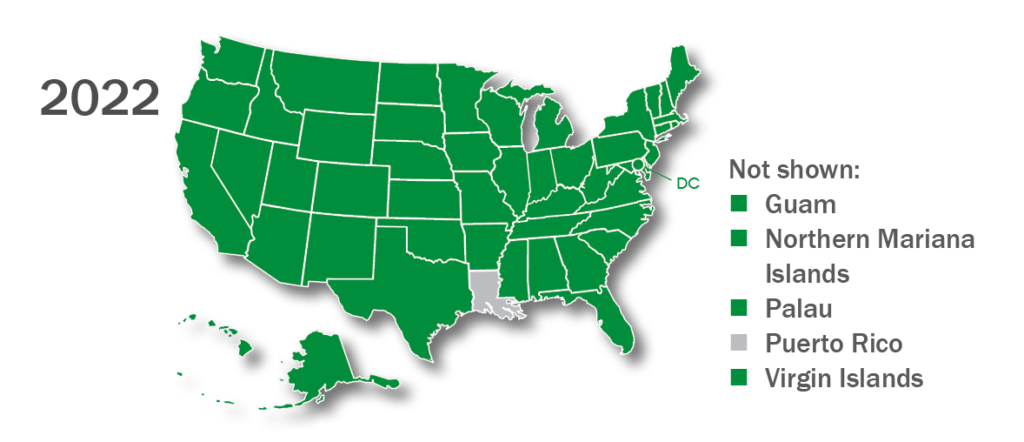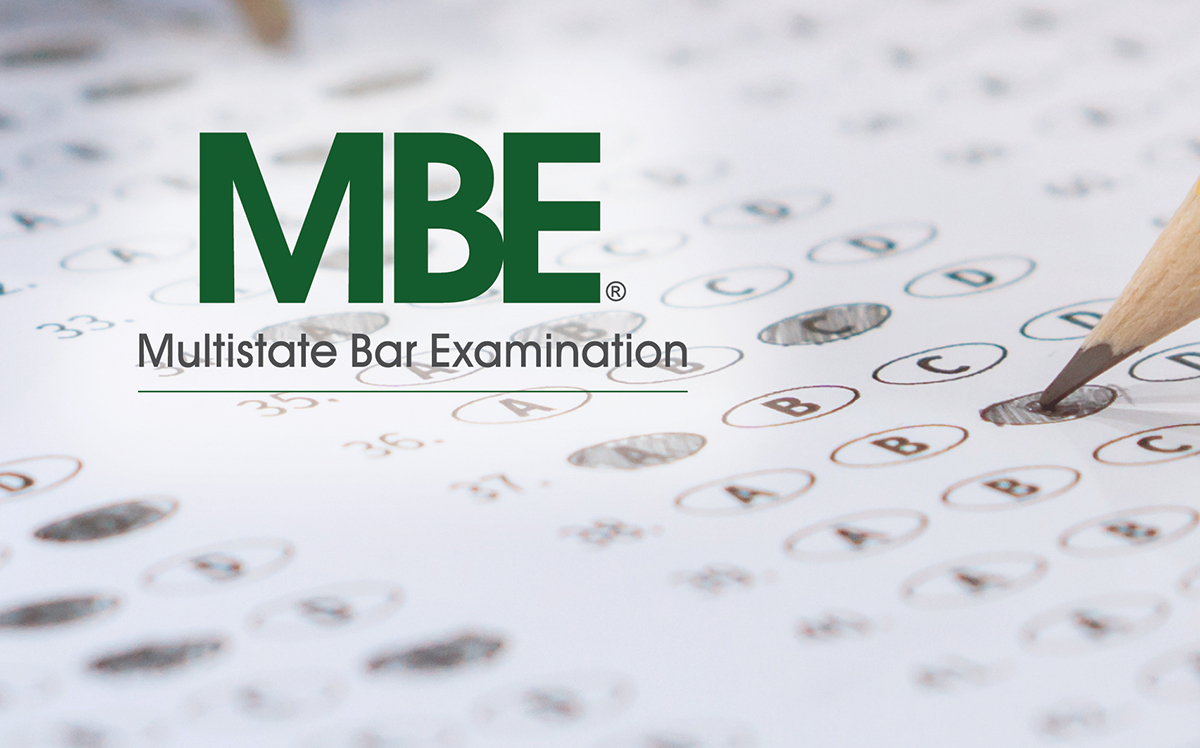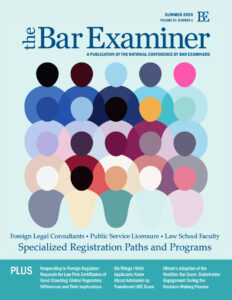This article originally appeared in The Bar Examiner print edition, Fall 2022 (Vol. 91, No. 3), pp. 7–12.

Fifty years ago, the Multistate Bar Examination (MBE) was administered for the first time to 4,955 examinees from 19 jurisdictions. Today, the MBE is administered by 54 jurisdictions—with 16,504 and 44,705 examinees having taken the MBE in February and July 2022, respectively.
Joe E. Covington, NCBE’s first director of testing from 1969 to 1985, and John F. Germany, NCBE Board of Trustees chair from 1974 to 1976, were both instrumental in the birth of the MBE. This timeline, interspersed with quotes from Bar Examiner articles over the years, captures important milestones in the MBE’s 50-year history.


1968–1970
In the fall of 1968, NCBE establishes a special committee to study the bar examining process, with a goal of reporting to the Conference in 1970. The committee, whose members include Joe E. Covington and John F. Germany, first meets in January 1969. Recognizing that increasing numbers of law school graduates had led to delays in grading bar examinations, in turn delaying licensure for new attorneys across the country, the committee conducts an extensive feasibility study on the possibility of creating a uniform multiple-choice bar examination.
Covington and Germany reflect on the process leading to the launch of the exam and the genesis of its name:
“The [special] committee soon determined that there was a universal concern among bar examiners regarding the mounting burden the boards were having and would have in the preparation and grading of examinations in the light of increasing applications. The procedures in many States do not lend themselves easily to amendment to accommodate this increasing burden. The committee became aware of a receptivity by various boards to suggestions regarding solutions to this problem.
Its studies revealed to the committee that in the past decade or two tremendous progress has been made in the science of testing….
The committee made a careful investigation of State cooperation in testing for licensing by other professions. About a dozen professions, including doctors, nurses, professional engineers … and architects use uniform tests. It was found that in every instance they are using multiple-choice tests and are very happy with the results….
Based on its studies, the NCBE Special Bar Examination Committee recommended to the NCBE Board of Managers that a one-day test of multiple-choice questions on five subjects be made available to all States. The Board of Managers accepted the recommendation, established a standing Bar Examination Committee to ensure the continuity of the program and directed the committee to proceed with plans.”
— Joe E. Covington, “The Multi-State Bar Examination Program,” 40(5–6) The Bar Examiner 90–91 (1971).
“At the time, the states were fearful of a ‘national’ bar exam which could cause them to lose their jurisdiction over the admitting process. Joe [Covington] suggested we call our proposed examination a ‘multistate bar examination,’ and the name stuck….
All of us knew that we were breaking new ground which would change the testing process.… [M]ultiple choice questions were still generally looked upon as an unacceptable way to test legal knowledge. With the mounting number of applicants, however, the grading of essay papers was becoming onerous, and the delay in announcing the results was becoming unacceptable to both the state courts and the examinees. The time was ripe for a new examining process where a multistate test could be prepared according to professional standards and graded in a matter of a few weeks, giving jurisdictions additional time to grade any essays.”
— John Germany, “Joe Covington: A Remembrance,” 68(4) The Bar Examiner 7–10 (November 1999).
“…[T]o merely mention a ‘national bar examination’ causes a negative reaction for one starts thinking of the loss of local control of admission to the bar. To avoid this connotation, we should think in terms of a ‘multi-state’ bar examination. This is what I mean when I refer to a ‘standard bar examination,’ as one which would be administered for several States. The title suggests the possibility of ‘regional examinations.’ There is no reason to limit our thinking to a ‘regional examination’ for we may have several States not in the same region wishing to cooperate by using the same examination. So, ‘multi-state’ is the more descriptive word.”
— “A Uniform Bar Examination—National or Regional: Is It Possible or Practical?—Panel Discussion, Remarks of Joe E. Covington,” 39 (3–4) The Bar Examiner 61 (1970).
1970
Accepting the recommendations of the Special Committee, NCBE’s Board of Managers establishes a standing bar examination committee to begin developing a six-hour multiple-choice bar examination.
NCBE receives a grant from the American Bar Foundation to help cover the costs of developing the exam.
Boards of bar examiners, law school deans, and law school faculty are surveyed to gather suggestions for subject matter coverage. Drafting committees, made up of bar examiners and law school faculty, are formed, and NCBE contracts with the Educational Testing Service (ETS) to provide technical support for the exam.
1971
NCBE receives the first of two seed money grants from the American Bar Endowment for planning the MBE. Meetings are held in New York, Chicago, and San Francisco to present the new multiple-choice bar examination to jurisdictions. Representatives from 42 jurisdictions attend.
1972
The MBE is administered for the first time in February to a total of 4,955 examinees from 19 jurisdictions. This marks the establishment of a universal bar examination date for the first time, with the MBE administered on the last Wednesday in February and July. The exam contains 200 scored questions in five subject areas: Contracts, Criminal Law, Evidence, Real Property, and Torts. ETS scores and provides statistics on the exam. In July, 26 jurisdictions administer the MBE to a total of 11,672 examinees.
Jurisdictions First Administering the MBE in 1972, Number of Examinees
| Jurisdiction | February 1972 | July 1972 |
|---|---|---|
| Alaska | 39 | 56 |
| California | 1,728 | 3,904 |
| Colorado | 290 | 432 |
| Connecticut | — | 359 |
| Florida | 508 | 590 |
| Georgia | 409 | 542 |
| Hawaii | 58 | 82 |
| Illinois | 455 | — |
| Kansas | 70 | 156 |
| Kentucky | 87 | 190 |
| Maine | 49 | 93 |
| Maryland | — | 564 |
| Missouri | 110 | 376 |
| Nevada | — | 86 |
| New Hampshire | — | 106 |
| New Jersey | 387 | 879 |
| Ohio | 324 | 916 |
| Oregon | — | 368 |
| Pennsylvania | 211 | 1,140 |
| Rhode Island | 33 | 67 |
| South Carolina | 30 | 151 |
| South Dakota | — | 59 |
| Tennessee | 115 | 263 |
| Utah | 43 | 87 |
| Vermont | — | 65 |
| Wisconsin | — | 105 |
| Wyoming | 9 | 36 |
| TOTAL | 4,955 | 11,672 |
1974
The MBE is equated for the first time, using a linear model.
1975
Constitutional Law is added as a sixth MBE subject.
1982
An MBE content validity study is completed. An excerpt from the study concludes,
“[The] findings are strongly supportive of the structure, format, and content of the MBE relative to its use as part of a state licensing program.”
— “An Evaluation of the Multistate Bar Examination,” 52 (3) The Bar Examiner 26–28 (August 1983).
1984
MBE development, scoring, and equating moves from ETS to ACT.
1992
A second MBE content validity study is completed. In summarizing the conclusions of the two-year study, then–NCBE president Francis D. Morrissey writes,
“There is strong evidence from statistical analyses that the MBE is measuring what it is designed to measure: legal reasoning and knowledge that is material to the practice of law. Scores correlate highly with other indices of legal reasoning skills and knowledge. The test appears to be fair to all takers regardless of gender, race, or ethnicity.”
— Francis D. Morrissey, “President’s Page,” 62(4) The Bar Examiner 4–5 (November 1993).
As the MBE marks its 20th year, Covington is remembered for his role in launching the exam:
“The end of the second decade of the Multistate Bar Examination coincided with the death of Joe E. Covington, who, above all others, was the mentor of the program which conceived the examination, brought the concept to fruition, and guided it over the stormy seas of doubt and disclaimer to the prominent position it now holds in the bar admissions process.”
— John E. Holt-Harris, Jr., “Joe E. Covington, 1911–1993,” 62(4) The Bar Examiner 6–7 (November 1993).
1997
The MBE celebrates its 25th anniversary, with 52 jurisdictions administering the test to 62,596 examinees. Reflecting on this anniversary milestone, then–NCBE president Erica Moeser writes,
“In its infancy, the MBE had a lot going against it and a lot to overcome. The notion of applying the principles of standardized testing to the examination of lawyers for admission to the bar was no doubt counter-intuitive (and, dare one say, revolutionary) to generations of bar examiners who could only imagine bar exam testing conducted in an essay format….
The very idea that the sum of a legal education could be subjected to a form of measurement that came down to deciding among the choices presented by (a), (b), (c), and (d) seemed impossibly simplistic to those who were unaware of the sophistication underlying the development and administration of the 200 test items that comprise each MBE.”
— Erica Moeser, “President’s Page,” 66(4) The Bar Examiner 5–7 (November 1997).
2005
Equating for the MBE changes from a linear model to a three-parameter item-response-theory model. Moeser announces,
“The transition from linear equating to IRT (item response theory) equating is complete for the MBE. This was an important step to take, and one that has produced no negative fallout. The MBE test development effort continues to be of high quality, with some evolution in the style of the items as they are crafted for use. Our July MBE produced the highest reliability figure in memory; for those of us not immersed in measurement, let’s just say this test form earned a gold star.”
—Erica Moeser, “President’s Page,” 74(4) The Bar Examiner 4–5 (November 2005).
2007
Pretesting of MBE questions begins, with 10 of the 200 questions allocated as unscored questions. Beth Donahue, then–MBE Program Director for NCBE, explains,
“[T]he addition of pretesting—using items on an examination that are being ‘tried out’ but do not count in the examinees’ scores … has been an enormous milestone….
The significance of pretesting is hard to overstate. It allows NCBE’s drafting committees to rework questions that do not perform as expected, making them harder or easier, or eliminating subtle ambiguities that may have gone unnoticed during the drafting and editing processes. When questions that have been pretested are placed on exams as scored questions, there is greater assurance that they will function as intended (by discriminating between highly knowledgeable applicants and less knowledgeable applicants). With the limited amount of testing time, each question on the examination should shoulder some of this discriminatory burden, and the pretesting process has gone a long way toward ensuring that result.”
—Beth E. Donahue, “Recent Changes in NCBE’s Multiple-Choice Examination Programs,” 77(3) The Bar Examiner 25–30 (August 2008).
2009
NCBE takes over MBE test development from ACT.
2011
NCBE takes over MBE scoring and equating from ACT. February 2011 is the first MBE administration that is developed, scored, and equated entirely by NCBE.
2012
A new content validity study of NCBE’s overall testing program is completed in the form of a job analysis of the legal profession to determine the job activities of newly licensed lawyers—what new lawyers do, and what knowledge, skills, and abilities newly licensed lawyers believe that they need to carry out their work. The purpose of the study is to describe the job activities of newly licensed lawyers in sufficient detail to provide a job-related and valid basis for the development of NCBE’s exams, including the MBE.
Applied Measurement Professionals, Inc., the organization commissioned by NCBE to perform the job analysis, concludes in its report,
“NCBE can be confident that this study presents substantial validity evidence to support this content domain. When licensing examinations offered by NCBE are directly linked to this content domain, valid inferences from examination scores can be made that successful candidates possess the competencies necessary for newly licensed lawyers.”
— Applied Measurement Professionals, Inc., “A Study of the Newly Licensed Lawyer, Conducted for the National Conference of Bar Examiners,” prepared by Steven S. Nettles, EdD, and James Hellrung, MA (July 2012), p. 44.
The job analysis is subsequently used along with the opinions of subject matter experts to shape the test blueprints and subject matter outlines for NCBE’s exams.
2015
Civil Procedure is added as a seventh MBE subject.
2017
The number of MBE pretest questions is increased from 10 to 25 of the 200 total questions on each test form. In explaining this change, Moeser writes,
“We knew when we authorized the change that the results were expected to be positive, and they are. Measurement literature and practice support that testing 25 items in each content area is adequate. The reliability of the February 2017 MBE was .92—the highest it has ever been for a February MBE. To understand why reliability could remain high despite a reduction in the number of live items per content area, consider that previously MBE questions appearing for the first time were live items. Some performed well, of course, but others did not. Using items that have been pretested as we do now allows us to pick and choose among well-performing pretest items so that every live question is expected to contribute to the ultimate score. Our yield of high-quality test questions is therefore very high under the current model—a model, I should add, that comports with industry standards. It bears remembering that prior to the early 2000s there were no pretested items at all on the MBE. The move toward pretesting got under way during the early years of this century with the encouragement (and prodding!) of Dr. Susan Case and Dr. Michael Kane, top-flight measurement people who had recently joined the staff here.”
—Erica Moeser, “President’s Page,” 86(2) The Bar Examiner 5–6 (June 2017).
2022
The MBE celebrates its 50th anniversary! The MBE is now administered in 54 jurisdictions, with 61,209 examinees taking the exam in 2022.
2022–2023 MBE Policy Committee
- Hon. Cynthia L. Martin (MO), Chair
- David R. Boyd (AL)
- Hon. Noma Gurich (OK)
- Hon. Jill J. Karofsky (WI)
- Augustin Rivera, Jr. (TX)
- Darin B. Scheer (WY)
- Anthony R. Simon (MS)
- Timothy Y. Wong (MN)
(NCBE President Judith A. Gundersen is an ex-officio member of the committee.)
Learn More
For more background and history on the MBE, see the following articles and more at www.thebarexaminer.org
- Douglas D. Roche, “The Early Days of NCBE’s MBE Committee: Reminiscences from a Former Chair,” 81(4) The Bar Examiner 14–16 (December 2012).
- David R. Boyd, “A Milestone Birthday for the MBE,” 81(3) The Bar Examiner 25–30 (September 2012).
Contact us to request a pdf file of the original article as it appeared in the print edition.








